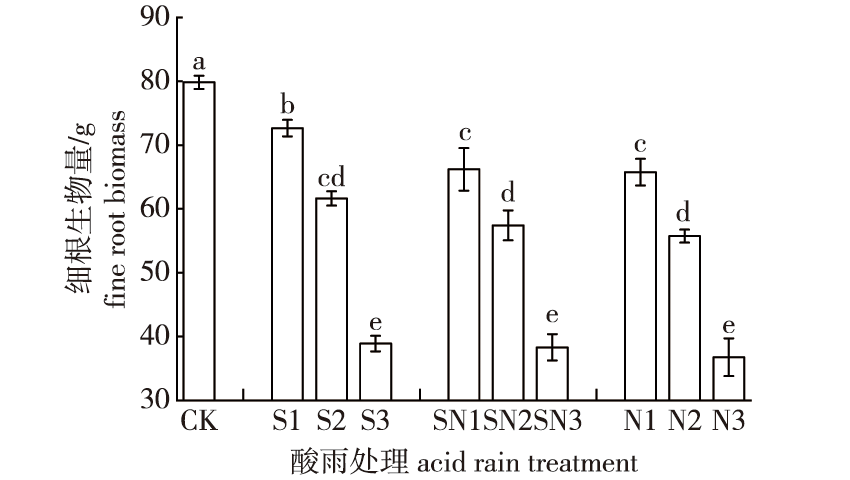 PDF(2264 KB)
PDF(2264 KB)


酸雨类型转变对杉木林地土壤和细根生长的影响
丁咏, 刘鑫, 张金池, 王宇浩, 陈美玲, 李涛, 刘孝武, 周悦湘, 孙连浩, 廖艺
南京林业大学学报(自然科学版) ›› 2024, Vol. 48 ›› Issue (3) : 90-98.
 PDF(2264 KB)
PDF(2264 KB)
 PDF(2264 KB)
PDF(2264 KB)
酸雨类型转变对杉木林地土壤和细根生长的影响
Effects of acid rain-based transformation on Cunninghamia lanceolata fine root growth and soil nutrient content
【目的】 探究酸雨类型转变对杉木细根生长和土壤养分含量的影响,为改善酸雨胁迫地区杉木人工林土壤酸化提供依据。【方法】 在江苏南京铜山林场进行了为期1 a的野外模拟酸雨试验,设置了3种酸雨酸度(pH为4.5,3.5和2.5)和3种酸雨类型[硫酸型酸雨,SO42-与NO3-的浓度比(硫氮比)5∶1。混合型酸雨,硫氮比1∶1。硝酸型酸雨,硫氮比1∶5],并设置对照CK(pH为6.6,利用当地自然溪水),共10个试验处理。分别测定酸雨胁迫后杉木林地土壤化学性质、细根生理特性及细根元素含量,利用相关性及结构方程模型分析方法,探究酸雨类型转变对杉木细根生长的直接及间接影响。【结果】 随着酸雨pH和硫氮比的降低,杉木细根生物量和根系活力均减少。所有强酸雨处理(pH 2.5)杉木根系的过氧化氢酶活性均低于其他酸雨处理,且当酸雨类型转变为硝酸型酸雨时,过氧化氢酶活性逐渐降低并低于CK;另外,细根镁、铝含量及钙铝比(含量比,下同)和镁铝比在不同的硫氮比处理之间均存在差异。与CK相比,所有酸雨处理均增加了细根钙和铝含量,钾含量随着酸雨胁迫逐渐减少。然而,土壤养分总碳、总氮、碳氮比、总硫、有效磷和速效钾在不同硫氮比和不同pH之间不存在显著差异。通过相关性分析可知:土壤pH与镁铝比、根系生物量和根系活力呈极显著正相关(P<0.01),并且根系生物量与过氧化物酶、过氧化氢酶之间均呈显著正相关(P<0.05),却与铝含量呈极显著负相关(P<0.01)。【结论】 酸雨酸度对杉木细根和土壤均有较大影响,酸雨类型对细根的影响要强于土壤。其中,酸雨类型对根系活力和钙铝比均有直接影响。随着硫氮比值的降低,酸雨对杉木细根生长的抑制作用更明显。
【Objective】 This study explored the effects of acid rain-based changes in soil nutrient content and Chinese fir (Cunninghamia lanceolata) fine root growth, to provide a theoretical basis for improving soil acidification of C. lanceolata plantations in acid rain-stressed areas.【Method】 A one-year simulated acid rain field experiment was conducted at the Tongshan Forest Farm in Nanjing, Jiangsu Province. Three acid rain acidity levels (pH=4.5, 3.5, and 2.5) were applied with each of three acid rain types: sulfuric acid rain, with 5∶1 concentration ratio of sulfur (S, SO42-) to nitrogen (N, NO3-); mixed acid rain, with 1∶1 S/N ratio; nitric acid rain, with 1∶5 S/N ratio; and a control (CK, pH=6.6, local river water). There were thus 10 total experimental treatments. Outcome measures of acid rain stress included soil chemical properties, fine root physiological characteristics, and fine root element contents. Correlations and structural equation model analyses were used to explore the direct and indirect effects of acid rain type on C. lanceolata fine root growth.【Result】 With decreasing acid rain pH and S/N ratios, the fine root biomass and root activity of C. lanceolata decreased. The catalase activity of all strong acid rain treatments (pH=2.5) was lower than that of other acid rain treatments. Compared with nitric acid rain types, the catalase activity incrementally decreased and was lower than CK; Mg and Al content, as well as the c(Ca)/c(Al) and c(Mg)/c(Al) in fine roots also differed. Compared with CK, all acid rain treatments increased fine root Ca and Al contents, while K content decreased with acid rain stress. However, there were not significant differences in soil total C, total N, C/N ratio, total S, available P, or available K among S/N ratios or pH levels. Correlation analysis showed that soil pH was extremely significant positively correlated with c(Mg)/c(Al), root biomass, and root activity (P<0.01), and that root biomass was significantly positively correlated with peroxidase, catalase, but extremely significant negative correlated with Al content (P<0.05). 【Conclusion】 After one year of experimental acid rain stress, acidity significantly impacted both soil and C. lanceolata fine roots. Acid rain type affected fine roots more strongly than it affected soil. As the S/N ratio decreased, the inhibitory effect of acid rain on C. lanceolata fine root growth was more pronounced.

Cunninghamia lanceolata / acid rain / sulfur to nitrogen ratio / fine root biomass / soil nutrient
| [1] |
|
| [2] |
盛炜彤. 关于我国人工林长期生产力的保持[J]. 林业科学研究, 2018, 31(1): 1-14.
|
| [3] |
|
| [4] |
黄爱梅, 方毅, 孙俊, 等. 武夷山不同海拔毛竹细根功能性状研究[J]. 生态学报, 2023, 43(1): 1-10.
|
| [5] |
张治军. 重庆酸雨区马尾松生物量和根系空间分布特征研究[D]. 保定: 河北农业大学, 2006.
|
| [6] |
|
| [7] |
|
| [8] |
|
| [9] |
李沁宇, 刘鑫, 张金池. 长三角区域酸雨类型转变趋势研究[J]. 南京林业大学学报(自然科学版), 2021, 45(1): 168-174.
|
| [10] |
|
| [11] |
|
| [12] |
|
| [13] |
|
| [14] |
|
| [15] |
许振柱, 周广胜. 植物氮代谢及其环境调节研究进展[J]. 应用生态学报, 2004, 15(3): 511-516.
|
| [16] |
|
| [17] |
|
| [18] |
陈美玲, 刘鑫, 陈新峰, 等. 酸雨类型转变对杉木林土壤养分特征和微生物量碳氮的影响[J]. 浙江农林大学学报, 2022, 39(6): 1278-1288.
|
| [19] |
赵文瑞. 酸雨酸度和硫氮比对麻栎细根生长及其主要组成物质的影响[D]. 南京: 南京林业大学, 2017.
|
| [20] |
童贯和, 程滨, 胡云虎. 模拟酸雨及其酸化土壤对小麦幼苗生物量和某些生理活动的影响[J]. 作物学报, 2005, 31(9): 1207-1214.
|
| [21] |
林妙君, 林敏丹, 许展颖, 等. 酸雨胁迫对水稻萌芽及幼苗生长的影响[J]. 广东农业科学, 2022, 49(4): 1-7.
|
| [22] |
|
| [23] |
|
| [24] |
|
| [25] |
张濛, 续高山, 滕志远, 等. 模拟酸雨对小黑杨幼苗生长和光合特性的影响[J]. 南京林业大学学报(自然科学版), 2021, 45(6): 57-64.
|
| [26] |
|
| [27] |
|
| [28] |
|
| [29] |
|
| [30] |
刘鑫. 长三角区域典型林分土壤及树木细根对酸雨的响应[D]. 南京: 南京林业大学, 2018.
|
| [31] |
|
| [32] |
乔芳. 拟南芥对三种类型模拟酸雨不同响应机制研究[D]. 厦门: 厦门大学, 2014.
|
| [33] |
孙业民, 马兰, 李朝周. 不同类型酸胁迫对云杉叶细胞膜及其保护系统损伤机制的比较[J]. 林业科学, 2012, 48(6): 56-62.
|
| [34] |
|
/
| 〈 |
|
〉 |